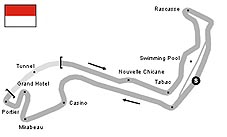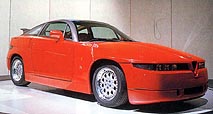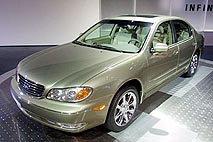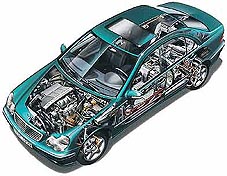 The classic “Round the Houses” race is on this weekend, but let’s look at a
little bit of history. The first Grand Prix in the “modern” genre was held at this Monaco circuit in 1950 and was over 100 laps. The winner? None other than the finest
driver the world has ever seen - Juan Manuel Fangio, who led every lap in his Alfa Romeo and was over one clear lap ahead of second placed driver Alberto Ascari at the
finish. The race took 3 hours, 13 minutes. Fangio also took pole with a time of 1 minute 50 seconds.
The classic “Round the Houses” race is on this weekend, but let’s look at a
little bit of history. The first Grand Prix in the “modern” genre was held at this Monaco circuit in 1950 and was over 100 laps. The winner? None other than the finest
driver the world has ever seen - Juan Manuel Fangio, who led every lap in his Alfa Romeo and was over one clear lap ahead of second placed driver Alberto Ascari at the
finish. The race took 3 hours, 13 minutes. Fangio also took pole with a time of 1 minute 50 seconds.
Now compare that to last year’s Monaco where this race (now only 78 laps) was
won by David Coulthard in the McLaren Mercedes who took over the lead after Michael Schumacher’s Ferrari had a suspension collapse. The race took 1 hour 49 minutes and the
pole was set by Schumacher at 1 minute 19 seconds. No wonder today’s drivers look fresh as they jump out of the cockpits - Coulthard and Co are at it for 109 minutes, while
Fangio and his ilk wrestled with their monsters for 193 minutes - almost twice as long.
For those with a knack for figures, the record for the greatest number of wins at this circuit is held by Ayrton Senna with 6, including 5 on the trot
between 1989 and 1993 inclusive. After that it is Graham Hill with 5 and Alain Prost with 4.
The big question at present is whether the teams have mastered the “Sticktion Control” and will actually get the cars off the line. It should be an
interesting race this Sunday.
Join me “trackside” at Shenanigans to watch it in front of the big screen. The race starts at 7 p.m., but most of us get there early to get a good seat
and have something from the carvery in the hour beforehand. See you there.
Autotrivia Quiz
Last week I wrote about Alfa Romeo who sold a two-door sports coupe for the general public. This car was a racing 75 in a GRP body, with the V6 engine
tweaked further. Top speed was 245 KPH. I asked what was this car and who built it? It was the Alfa Romeo SZ which was released at the Geneva Motor Show in 1989 and was built
by Zagato. Production ceased in 1994.
So to this week... And it’s an easy one. Henry Ford held a Land Speed record in the early 1900’s. It was almost not allowed. Why?
For the Automania FREE beer this week, be the first correct answer to fax 427 596 or email [email protected]
Baby FIAT’s
Dribbling down Beach Road Jomtien the other day I came across a crowd of people at the side of the road. Thinking it was a road accident or something I
slowed down to find that the cause for ogling was a genuine FIAT Jolly, the open version of the venerable FIAT 500. These were made by Vignale and really are a collector’s
item. They were so small that the Jolly I saw was parked at 90 degrees to the kerb and it still didn’t poke out into the traffic on the road.
 FIAT made almost four million of the babies over the 20 year production run. The
engine was an air-cooled flat twin developing a lusty 18 BHP and they also had a crash (non-synchro) gearbox.
FIAT made almost four million of the babies over the 20 year production run. The
engine was an air-cooled flat twin developing a lusty 18 BHP and they also had a crash (non-synchro) gearbox.
A mate in Oz has the ultimate FIAT 500, an Abarth version which he reckons he will one day restore and one which he will not part with.
 Anatomy of F1 racing
Anatomy of F1 racing
I got the following direct from the FIA which gives you an idea of just what the modern F1 cars are like and what restrictions there are. In addition to a
large number of specifications relating to chassis dimensions and aerodynamics, the current formula restricts the cylinder capacity of the engine to 3 litres, prohibits
supercharging and stipulates a minimum weight of 600 kg, including the weight of the driver and his race equipment. All engines must be reciprocating four stroke with ten
cylinders, none of which may be oval. (Now there’s a thought, I wonder if Ford tried running Blue Oval cylinders?) It is also obligatory for each car to have four wheels,
only two of which are driven.
If you think that some of that is stating the obvious, you must remember just how devious race car designers can be. Remember the 6 wheel Tyrrells for
example. Or the Brabham “fan” cars that sucked the air out from under the car.
These modern F1 cars are also very fast. In 1999, the fastest Grand Prix was the Italian, won by Heinz-Harald Frentzen (Jordan Mugen Honda) at an average
speed of 237.938 kph (147.848 mph). The highest speed recorded during practice in 1999 was 251.989 kph (156.579 mph), which was set at Monza by Mikka Hakkinen (McLaren
Mercedes), whilst the highest straight line speed recorded during a Grand Prix in the 1999 season was set by David Coulthard (McLaren Mercedes), at 361.8 kph (221.1 mph),
during the Italian Grand Prix.
Many people also do not understand how the Qualifying sessions work. Qualifying is a game of chance, where in the allotted 60 minutes, the driver has to
work out how to get his fastest possible lap time, generally towards the end of the hour when the track has warmed up and the corners are at their stickiest, but at the same
time avoid other drivers who are trying to do the same, while hoping nobody blows up and dumps oil on the circuit. The number of laps he can do is also limited, with a
maximum of 12 laps being allowed and any driver running over the maximum of 12 will have all his qualifying times cancelled. To compound the problems, a driver has to set a
time within 107% of the time set by the pole position winner. When Schumi pulls out a blinder to get pole, the back markers can really be up against it. You need a really
good excuse to get a start if you were outside the cut-off time.
New Cefiro

The proposed 2002 Infiniti was on display at the New York Show. These are sold as the Cefiro in Thailand, and the new model appears to have only minor
detail changes. At a bit over one million, the Cefiro represents one of the best value packages around. Quiet, comfortable and quality built. Ask any owner if they’re happy
- all the ones I have spoken to are very positive.
Anatomy of a road going car
A couple of weeks back I mentioned the fact that many car manufacturers actually farm out the production of their cars to outside manufacturers, who build
the whole car and send it back to the original name “manufacturer” to sell. What many people also do not realize is that any motor vehicle these days is actually produced
by dozens of component manufacturing firms who supply the name brand manufacturer.
 Take for example Mercedes Benz. There are over 30 component manufacturers involved
with supplying some very necessary bits and pieces for a Benz. Now imagine, if you will, just how Benz ensures the supplier keeps up the quality control. If a bit supplied
by, say, Delphi systems fails, the owner doesn’t ring Delphi - he rings MB and complains about MB in public. It’s a Benz, not a “Delphi” after all. A difficult
situation to be in for the car manufacturers!
Take for example Mercedes Benz. There are over 30 component manufacturers involved
with supplying some very necessary bits and pieces for a Benz. Now imagine, if you will, just how Benz ensures the supplier keeps up the quality control. If a bit supplied
by, say, Delphi systems fails, the owner doesn’t ring Delphi - he rings MB and complains about MB in public. It’s a Benz, not a “Delphi” after all. A difficult
situation to be in for the car manufacturers!
As an example, here are some of the bits and pieces supplied to DaimlerChrysler for a Benz. Struts, monotube & load levelling: SACHS, Instrument panel:
JOHNSON CONTROLS / SOMMER-ALLIBERT, Alternator: DELPHI / VALEO, Oil cooler: VALEO, Wheel bearings: FAG KUGELFISCHER, Engine management: BOSCH / MAGNETI MARELLI, Side impact
module: TRW, Pillar trim: LEAR, Seat belts: TRW / TAKATA, Antenna: DELPHI, Emission control: TENNECO AUTOMOTIVE / FARACIA / EBERSPAECHER, Suspension components: ZF GROUP,
Steering wheel & airbag: PETRI, Instrument cluster: VDO, Navigation system: BOSCH.
That should be enough for you to see what a miracle it is that any car ever gets built and that it will run any period of time. Pity the manufacturer, as
when something goes wrong, the buck stops on the manufacturer’s desk. Many of the car recalls that the manufacturer has to wear may be caused by component defects which are
beyond the manufacturer’s control - but he cops it anyway!
Mercedes-Benz warranty costs soar
Further on the above topic, DaimlerChrysler is facing increased quality problems with its Mercedes Benz luxury car unit, according to the Financial Times.
Quality problems resulted in nearly USD 1.5 billion in warranty payments in 2000 representing a 300% increase in costs in the past two years.
According to their sources, many of the quality problems associated with Mercedes Benz products result from growing pressures to shorten development times
and cut quality control costs.